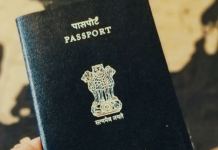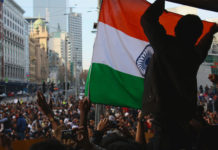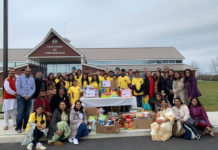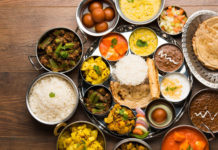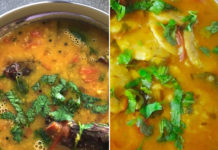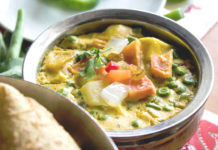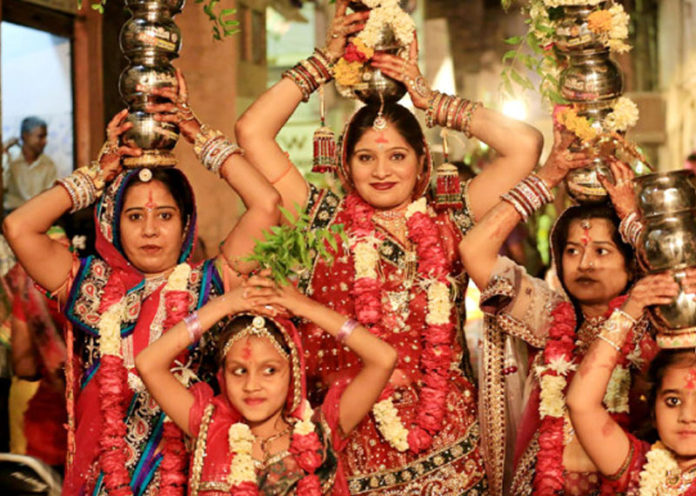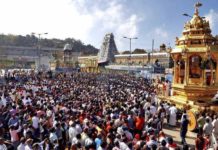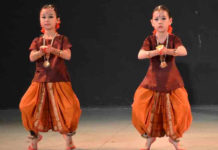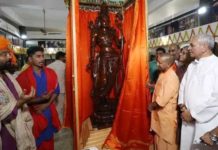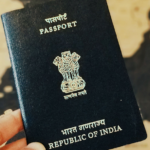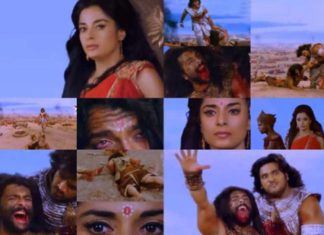Gangaur is celebrate in honor of Goddess Gauri. A manifestation of Parvati, representing purity and austerity.
“Gana” is another word for Lord Shiva, and Gangaur signifies Lord Shiva and Goddess Parvati together. It’s believed that Parvati returned to her parental home to bless her friends with marital bliss. On her last day, she was given a grand farewell by her loved ones and Lord Shiva arrived to escort her home.
 Gangaur is celebrated all over Rajasthan and is one of the state’s most important festivals. The festival is predominantly for women, who dress up in their best clothes pray for a husband of their choice, or the welfare of their husbands.
Gangaur is celebrated all over Rajasthan and is one of the state’s most important festivals. The festival is predominantly for women, who dress up in their best clothes pray for a husband of their choice, or the welfare of their husbands.
 In Udaipur, there’s a boat procession on Lake Pichola, and fireworks. In Jodhpur, thousands of maidens dress up, sing, and carry water and grass in pots.
In Udaipur, there’s a boat procession on Lake Pichola, and fireworks. In Jodhpur, thousands of maidens dress up, sing, and carry water and grass in pots.
 While in Jaipur, the pomp and pageantry of the traditional procession includes Elephants, old palanquins, chariots, bullock carts, and folk performances.
While in Jaipur, the pomp and pageantry of the traditional procession includes Elephants, old palanquins, chariots, bullock carts, and folk performances.
 Clay idols of Shiva and Parvati, to be worshiped during the festival, are decorated, and placed in a basket with grass and flowers. Wheat, sown in small earthen pots and the wheat grass is used for worship on the final day. Water pots are also decorated with traditional Rajasthani maandna (a special type of painting done with lime water).
Clay idols of Shiva and Parvati, to be worshiped during the festival, are decorated, and placed in a basket with grass and flowers. Wheat, sown in small earthen pots and the wheat grass is used for worship on the final day. Water pots are also decorated with traditional Rajasthani maandna (a special type of painting done with lime water).
 All newly married women must fast for the whole 18 days of the festival. Even unmarried women fast in the hope of finding a good husband. On the second last day of the festival, known as Sinjara, the parents of married women send their daughters sweets, clothes, jewelry and other decorative items. The women dress up in these items and adorn their hands and feet with mehendi (henna), and celebrate with their families.
All newly married women must fast for the whole 18 days of the festival. Even unmarried women fast in the hope of finding a good husband. On the second last day of the festival, known as Sinjara, the parents of married women send their daughters sweets, clothes, jewelry and other decorative items. The women dress up in these items and adorn their hands and feet with mehendi (henna), and celebrate with their families.
 The festival culminates in Gauri’s departure on the last day, and the immersion of the clay idols in water.
The festival culminates in Gauri’s departure on the last day, and the immersion of the clay idols in water.
 Gangaur is also an auspicious time of year to select a life partner. Tribal men and women get the opportunity to meet and interact, pick partners, and elope and marry.
Gangaur is also an auspicious time of year to select a life partner. Tribal men and women get the opportunity to meet and interact, pick partners, and elope and marry.
By: Archa Dave










